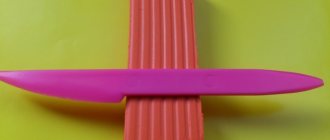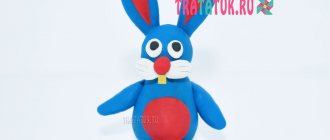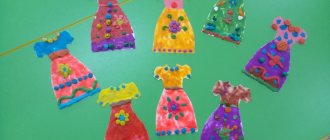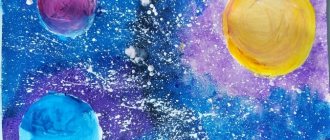MAGAZINE Preschooler.RF
“Magic Modeling” program for the senior groupGoal: Development of creative abilities in children of senior preschool age.
Objectives of the circle: introduce children to unconventional modeling techniques, coloring finished products; consolidation of knowledge about Dymkovo, Khokhloma, Gzhel paintings; fix relief, volumetric modeling; introduce the technique of making salt dough products; to develop an interest in performing creative works using different materials and methods; consolidate children's knowledge of materials that can be worked with and be able to use them correctly.
Explanatory note:
Our time requires creative, non-standard people who think and act for the benefit of the development of the individual and society. Therefore, the social order of society is to develop children’s creative abilities, the ability to think outside the box, not to be afraid to express opinions that differ from the generally accepted, to see the unusual in the ordinary.
According to psychologists and teachers, preschool age is the most favorable for the development of thinking and imagination - a mental process that forms the basis of creative activity. Therefore, the development of creativity is one of the main tasks of preschool education and upbringing.
The use of non-traditional modeling techniques in the practice of working with children works to solve several developmental problems at once:
- development of children's creative abilities (in all the diversity of this concept);
- development and improvement of fine finger motor skills;
- developing skills and abilities to work with various materials, devices and tools;
- acquaintance with new techniques and technologies;
- ability to apply them in practice.
Frequency of the circle: once a week for one academic year.
Duration of the circle: 25 minutes.
Expected student results:
Sculpts objects of various shapes using learned techniques and methods of sculpting;
Creates small plot compositions, conveying proportions, poses and movements of figures.
Creates images based on folk toys.
September:
1. Topic: “Apples and pears.” Gifts of autumn. Signs of autumn.
Goals and objectives: Practice rolling a ball, oval, flattening, using natural material to complement the craft.
Materials and equipment: Salt dough, dummies of fruits, stacks,
reproduction of paintings with fruits. (1/59)
2. Theme: “Sunflower”
Goals and objectives: Practice rolling a ball, oval, flattening, using natural material to complement the craft.
Materials and equipment: Salt dough, photo of a sunflower, stack, seeds. (11/14)
3. Theme: Decorative plate “Rose”. Gifts of autumn.
Goals and objectives: To develop the ability to sculpt a rose from individual parts, roll out balls, flatten, and make a flower of 6-8 petals. Develop finger flexibility and learn to see the end result.
Materials and equipment: Clay, stack (11/20, 3/61)
4. Topic: Painting the decorative plate “Roses” in the Gzhel style
Goals and objectives: To introduce children to folk art. Continue to develop the ability to paint products after drying, select paints, mix, to obtain the desired shade. Place the work on a plate.
Materials and equipment: Gouache, brushes, palette, dishes with Gzhel painting (8/85)
October:
1. Topic: “Prickly hedgehog.” Animal behavior in autumn.
Goals and objectives: Separately sculpt needles in the shape of a cone, connect the parts. Supplement the work with fungi and apples.
Materials and equipment: Colored salt dough, stack, slide with a picture of a hedgehog in the forest in autumn (11/12)
2. Topic: “The horse is beautiful, daring”
Goals and objectives: Continue to introduce children to folk art. Model a horse from a whole piece of clay. Develop finger flexibility and learn to see the end result.
Materials and equipment: Clay, stack, water, photo of the Filimonovsky horse (2/56)
3. Topic: “Kargopol goat”
Goals and objectives: Continue to introduce children to folk art. Model a horse from a whole piece of clay. Develop finger flexibility and learn to see the end result.
Materials and equipment: Clay, stack, water, photo of the Kargopol goat (1/112)
4. Theme: “Elephant”
Goals and objectives: Strengthen the ability to sculpt three-dimensional things and develop motor skills.
Materials and equipment: Plasticine, stack, photo of an elephant, sample of an elephant (5/14)
November:
1. Topic: “Ladybug” (on a leaf)
Goals and objectives: Learn to sculpt a ladybug from parts: head, body, using moldings, additional material for decoration. Use a leaf cutter. Be able to regulate the pressure when performing moldings.
Materials and equipment: Salt dough, leaf mold, toy, water, brush (12)
2. Topic: Coloring with “Ladybug” paints.
Goals and objectives: To develop skills of accuracy when coloring work. Be able to use unconventional drawing skills - with your finger, to draw dots. Exercise in ways of working with paints, designing work on a piece of paper.
Materials and equipment: Gouache, brush, glue (12)
3. Topic: “Panel with flowers” (sgraffito).
Goals and objectives: Familiarization with the technique of sgraffito - “scratched” on plasticine. plasticine,
Materials and equipment: cardboard, stack, painting with flowers
4. Topic: “Penguins on an ice floe.”
Goals and objectives: Continue to develop the ability to sculpt a figurine from a whole piece, using the techniques of rolling, stretching, flattening, cutting in stacks, conveying their characteristic features and proportions. Use foil when sculpting the body. Develop children's imagination and intelligence.
Materials and equipment: Salt dough, foil, foam. (11/8)
December:
1. Topic: Coloring with paints “Penguin on an Ice Floe”.
Goals and objectives: Continue to develop children’s ability to paint figures after drying, to combine them into a common composition. To develop children’s ability to accurately convey a conceived idea when coloring a product.
Materials and equipment: Gouache, brush, glue. (11/8)
2. Theme: “Christmas tree under the snow” (relief modeling)
Goals and objectives: Introducing children to a new modeling technique - plasticine stretching. Materials and equipment: plasticine, stack, card with Christmas tree (13)
3. Theme: “Snow Maiden”
Goals and objectives: To learn to reflect the impressions received while observing winter nature. Develop artistic and creative abilities.
Materials and equipment: Clay, model of the Snow Maiden (10/24)
4. Topic: Painting the Snow Maiden with Gzhel paintings.
Goals and objectives: Repeat the “Gzhel” painting with the children. Exercise in ways of working with paints, develop aesthetic perception and sense of color. Continue to develop the ability to see the end result of the planned work.
Materials and equipment: Gouache, brush, palette. Folk painting “Gzhel” (8/85)
January:
1. Theme: “Elegant Christmas tree”
Goals and objectives: To develop the ability in children to cut out a Christmas tree using a stencil, smooth out the edges with a brush moistened with water, and independently come up with decorations - balls, toys, beads. Develop finger flexibility. Use familiar sculpting techniques in a new creative situation.
Materials and equipment: Salt dough, “Christmas tree” stencil made of cardboard, stack, beads. (17)
2. Topic: Coloring with paints “Elegant Christmas tree”.
Goals and objectives: Continue to develop the ability to paint a Christmas tree with paints, develop skills of accuracy when doing work. Develop creative imagination and coherent speech when writing stories about the Christmas tree. When decorating the Christmas tree, use various additional materials
Materials and equipment: Gouache, brushes, glue, threads, beads, confetti. (17)
3. Topic: “Kargopol horse”
Goals and objectives: Continue to develop the ability to sculpt from a whole piece of clay.
Materials and equipment: clay, stack. (7/8)
4. Topic: “Decorating the Kargopol horse.”
Goals and objectives: To practice ways of working with paints, to develop aesthetic perception and a sense of color. Instill a love for animals and a desire to help them.
Materials and equipment: Gouache, brush, palette (7/8)
February:
1. Topic: “Bear-folk toy”
Goal: Continue to strengthen the ability to sculpt from a single piece. Introduce the traditions of potters.
Materials and equipment: plasticine, stack (9/10)
2. Topic: “Mug for Dad.”
Goals and objectives: To develop children’s ability to sculpt a mug, roll out plasticine in the form of a strip, a ball, press a depression in it, and pinch the edges. Sculpt the initial letter of the name for decoration. Develop fine motor skills and imagination in decorating a souvenir. Materials and equipment: Plasticine, stack (6/28)
3. Theme: “Hearts”
Goals and objectives: Consolidating the ability to sculpt objects or parts of them from dough, using the movement of the entire hand.
Materials and equipment: Colored salt dough, water
4. Topic: “Stork on the roof.”
February: Practice “painting over” a picture with plasticine. Cultivate an interest in creativity.
Materials and equipment: Plasticine, cardboard, cards with migratory birds, encyclopedia about birds (15)
March:
1. Topic: “Four-legged friend”
Goals and objectives: To develop the ability to use knowledge about the features of the appearance of animals in their work. Strengthen the skills and abilities acquired earlier (rolling, flattening, pulling, smoothing edges). Develop creative imagination and interest in work.
Materials and equipment: Stacks, plasticine, cardboard (10/28)
2. Topic: Signs of spring.”Flower meadow.”
Goals and objectives: Improving manual labor skills by modeling from colored dough.
Materials and equipment: Colored dough, stacks, water, slides with spring flowers (11/14)
3. Theme: “Basket with flowers”
Goals and objectives: Continue to develop children’s ability to roll out clay in an even layer, cut out a basket using a stencil, and scratch with a fork. Tie the flagella together for the handle and bottom. Sculpt familiar flowers and leaves. Develop imagination and the desire to give joy to others.
Materials and equipment: Clay, fork, basket stencil, stack. (11/14)
4. Topic: Coloring the basket and flowers.
Goals and objectives: To cultivate interest in creativity, collectivism, and aesthetic perceptions.
Materials and equipment: Gouache, brush. (11/14)
April:
1. Topic: “Amazing underwater world” (plasticineography)
Goals and objectives: Introduction to non-traditional drawing techniques (plasticine).
Materials and equipment: plasticine, stack (11/26)
2. Topic: “Rocket”.
Goals and objectives: To develop the ability to make a cone-shaped shape. Develop fine motor skills of the hands.
Materials and equipment: Salted dough, stack. Rocket photo (14)
3. Theme: Geometric man
Goals and objectives: Continue to develop children’s ability to paint crafts after drying, selecting the right colors. To develop the ability to accurately convey a conceived idea when coloring a product, to reveal the creative imagination of children in the process of work.
Materials and equipment: Clay, skewer, paints, brush (6/14)
4. Topic: “My dad is a fireman”
Goals and objectives: Continue to develop the ability to sculpt funny little people using the techniques of rolling balls, ovals, flattening, and pulling. Use matches and sticks to connect the parts. Develop the ability to work collectively.
Materials and equipment: Clay, matches, sticks, stacks (2/79)
May:
1. Topic: “St. George’s Ribbon.”
Goals and objectives: To develop the ability to roll out clay with a rolling pin and cut out shapes according to a template. Cultivate an interest in creativity.
Materials and equipment: Plasticine, template, stack
2. Theme: “Clover”
Goals and objectives: To consolidate the ability to roll balls of different sizes. Continue learning how to apply a relief pattern using a stack.
Materials and equipment: Plasticine, template, stack (3/38)
3. Topic: “Circus in Samara.”
Goals and objectives: Continue to develop the ability to notice and convey in modeling the characteristic features of an architectural structure.
Materials and equipment: Plasticine, stack, circus photo (16)
4. Topic: “Children on a walk.”
Goals and objectives: Continue to teach children how to convey movement in sculpting.
Materials and equipment: Plasticine, stack. (2/80)
Bibliography:
- Bondarenko T.M. “Complex classes in the senior group of kindergarten.” EC "Teacher", Voronezh, 2007
- Volchkova V.N., Stepanova N.V. “Lesson notes for the senior group of kindergarten”, Voronezh, 2008
- Davydova G.N. “Plasticineography. Floral motifs", M., 2009
- “From birth to school”, edited by N.E. Veraksy, T.S. Komarova, M.A. Vasilyeva M., Mozaika-synthesis, 2014.
- Petrova O. “Animals made of plasticine.” FST-PRESS KNIGA LLC, M., 2013
- Plomer A.L. “Making from clay” Kharkov, 2013
- Educational publication “Art for children. Kargopol toy. ed. "MOSAIKA-SYNTHESIS", M., 2008
- Utkin P.I. "Folk artistic crafts of Russia." M., 1984
- Educational publication “Art for children. We are making a folk toy.” ed. "MOSAIKA-SYNTHESIS", M., 2010
- Educational publication “Art for children. Khokhloma painting". ed. "MOSAIKA-SYNTHESIS", M., 2010
- Firsova A “Miracles from salt dough.” LLC "AIRIS-press", M., 2013
| Next > |
Long-term plan for modeling in the senior group
Irina Bogacheva
Long-term plan for modeling in the senior group
T. S. Komarova “Lessons in visual arts in the senior group”
I. A. Lykova “Art activities in kindergarten. Senior group"
G. S. Shvaiko “Fine art classes in kindergarten. Senior group"
D. N. Koldina “ Modeling with children 5-6 years old”
SEPTEMBER
No. / DATE TYPE OF ORGANIZED EDUCATIONAL ACTIVITY
GOALS
LITERATURE
1
Plasticine molding “Bunch of grapes” Continue learning to roll plasticine balls between your palms and flatten them on top with your finger on the cardboard. Koldin “ Modeling with children 5-6 years old” , p. 13
2
modeling “Our favorite toys” Learn to sculpt toys, conveying their appearance. Learn to plan work - select the required amount of material, determine the method of sculpting Lykova “Art activities in kindergarten. Senior group” , p. 22
3
Modeling from plasticine “Mushrooms” Strengthen the ability to sculpt objects or their parts, using the movement of the fingers and the entire hand. Learn to convey the features of a species. Komarova “Classes in visual arts. Senior group . " ,With. 34
4
Modeling from plasticine “Fruit in a Vase” Learn to sculpt from life a complex shape of different sizes, using modeling to make dents. Learn to choose colors. Koldina, s. 15
OCTOBER
No. / DATE TYPE OF ORGANIZED EDUCATIONAL ACTIVITY
GOALS
LITERATURE
1
Modeling based on the Dymkovo toy “Goat” Continue to learn how to sculpt a figure based on folk motifs; use the technique of rolling out a column, bending it and cutting it in a stack at both ends. Komarova, s. 46
2
Applying plasticine to the “Truck” surface Continue learning how to apply plasticine to the surface, choosing the color. Koldina, s. 38
3
Modeling from plasticine “How little Mishutka saw that everything in his bowl had been eaten” Learn to create a fairy-tale image in modeling . Learn to sculpt the figure of a bear cub, conveying the shape of the parts, their relative size, location in relation to each other. Lead to an expressive image. Fairy tale character . Komarova, s. 45
4
Modeling from plasticine in combination with natural material “Hedgehog” Fix and convey proportions. Continue learning to connect the parts by pressing them. Develop imagination. Koldina, s. 20
NOVEMBER
No. / DATE TYPE OF ORGANIZED EDUCATIONAL ACTIVITY
GOALS
LITERATURE
1
modeling “Leaves dance and turn into trees” Introduce the technique of relief modeling . Develop a sense of shape and color. Lykova, s. 46
2
Modeling - experimenting with artistic materials “Feathered, shaggy, prickly” Arouse interest in experimenting with plastic materials and artistic tools to convey the texture of the body of animals. Lykova, s. 70
3
Modeling from plasticine “Oleshek” Learn to sculpt a figure from a whole piece, conveying the shape of individual parts using the pulling technique. Komarova, s. 56
4
Acquaintance with art - examination of ceramic dishes, decorated with paintings and reliefs. Introduce ceramic dishes, the material from which they are made; learn to distinguish the shape of the dishes: wide, tall. Introduce different ways of decorating dishes, painting and relief. Shvaiko “Fine art classes in kindergarten. Senior group” , p. 69
DECEMBER
No. / DATE TYPE OF ORGANIZED EDUCATIONAL ACTIVITY
GOALS
LITERATURE
1
Modeling from plasticine “Kitten” Learn to create the image of an animal in modeling . Strengthen the ability to sculpt in parts, using different techniques. Convey the animal's pose. Komarova, s. 63
2
Modeling from plasticine “Girl in a winter coat” Learn to sculpt a human figure, conveying the shape of clothing, body parts: observing proportions. Komarova, s. 67
3
Drawing on plasticine “Multi-colored Christmas tree” Learn to use graphic drawing techniques in modeling ; perform using the counter-relief method (pressed relief)
; Learn to combine several techniques in your work. Develop imagination. Koldina, s. 28
4
Modeling from plasticine “Snow Maiden” Learn to convey in modeling and consolidate the ability to convey the human figure: shape, location and size of parts. Cultivate the desire to complete work. Komarova, s. 71
JANUARY
No. / DATE TYPE OF ORGANIZED EDUCATIONAL ACTIVITY
GOALS
LITERATURE
1 Vacation
2
Modeling plot “Winter fun” Learn to create a collective composition from sculpted human figures. Fix the method of modeling from a cylinder , cut at both ends. Lykova, s. 114
3
Modeling from plasticine using a “Sheep” syringe, learn to sculpt the silhouette of an animal using the “sausage” technique, make wool by squeezing plasticine out of the syringe. Koldina, s. 32
4
Modeling with relief “Bowl with a pattern” Learn to convey the shape of a bowl in modeling ; decorate with a relief convex pattern - moldings. Shvaiko, s. 72
FEBRUARY
No. / DATE TYPE OF ORGANIZED EDUCATIONAL ACTIVITY
GOALS
LITERATURE
1
Modeling the plot “Dog with a puppy” Fix the method of modeling from a cylinder . independently compose a simple composition, correlate the parts by size. Lykova, s. 28
2
Modeling according to plan Develop the ability to independently conceive the content of your work and bring the plan to completion Komarov, p. 87
3
Modeling from plasticine “Tank” Learn to sculpt a tank from individual parts, correctly developing their shape and proportions. Continue to connect the parts, connect them tightly using the Koldin smear method, p. 37
4
Plasticineography on the disc “Flowers for Mom” Learn to make a composition in a circle using molding. Convey color similarities.
MARCH
No. / DATE TYPE OF ORGANIZED EDUCATIONAL ACTIVITY
GOALS
LITERATURE
1
Modeling from plasticine “Birds at the feeder” Develop perceptions, the ability to highlight the various properties of birds; compare birds. Learn to sculpt birds in parts, conveying the size of the body and head. Komarova, s. 92
2
Decorative relief molding Continue mastering the terrain. Show ray image options. Learn to create solar images. Lykova, s. 148
3
Modeling from plasticine “Giraffe” Learn to sculpt an animal from plasticine using a plastic method (from one piece, conveying proportions, characteristic details. Koldina, p. 25
4
Modeling from life “Wonderful shells” Improve the original form and modify it, supplement it with moldings; show double way, closing sink. Lykova, s. 192
APRIL
No. / DATE TYPE OF ORGANIZED EDUCATIONAL ACTIVITY
GOALS
LITERATURE
1
Modeling from plasticine “Cup” Learn to sculpt a cup consisting of rings and a disk, firmly connect the parts of the product to each other, smooth the surface Koldin, p. 21
2
Plasticine molding “Rainbow in the sky” Learn to form a planned object on a plane (bas-relief)
from columns, continue to supplement the work with compositional solutions. Koldina, s. 44
3
Modeling from salt dough “Ringing bells” Creation of voluminous hollow crafts from salt dough and decorative design according to Lykov’s plan, p. 104
4
Modeling from plasticine “Flower in a pot” Reinforce the ability to sculpt from plasticine using the techniques learned. Koldina, s. 44
MAY
No. / DATE TYPE OF ORGANIZED EDUCATIONAL ACTIVITY
GOALS
LITERATURE
1
modeling “We went to the meadow, we sculpted the meadow” Learn to sculpt your choice of meadow plants and insects, conveying their structure and color; giving stability. Lykova, s. 200
2
Modeling from plasticine in combination with additional material “Kinder - surprise” Strengthen the methods of modeling , achieving expressiveness of the image of the intended animal. Develop the ability to conceive the image of your work. Koldina, s. 48
3
Modeling from plasticine in combination with natural material “Ladybug” Continue to learn how to combine natural material in crafts. Learn to apply plasticine to an object, and independently bring the product to the image. Koldina, s. 49
4
Applying plasticine to the “Fish” surface Continue learning how to apply plasticine to the surface. (rhinestones) to plasticine
Koldina, s. 50
aniye.






